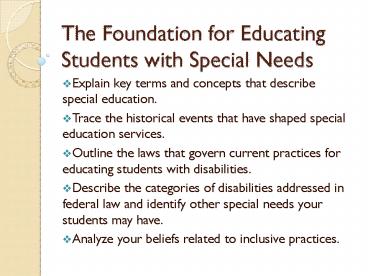The Foundation for Educating Students with Special Needs - PowerPoint PPT Presentation
1 / 16
Title:
The Foundation for Educating Students with Special Needs
Description:
The Foundation for Educating Students with Special Needs Explain key terms and concepts that describe special education. Trace the historical events that have shaped ... – PowerPoint PPT presentation
Number of Views:259
Avg rating:3.0/5.0
Title: The Foundation for Educating Students with Special Needs
1
The Foundation for Educating Students with
Special Needs
- Explain key terms and concepts that describe
special education. - Trace the historical events that have shaped
special education services. - Outline the laws that govern current practices
for educating students with disabilities. - Describe the categories of disabilities addressed
in federal law and identify other special needs
your students may have. - Analyze your beliefs related to inclusive
practices.
2
Thomas, Angela Aaron
- 1/3 of the room read the case study of Thomas.
- 1/3 of the room read the case study of Angela.
- 1/3 of the room read the case study of Aaron.
- Each group respond to the questions.
- Select a reporter from each group to describe the
student and share your groups responses.
3
Inclusion is.
- the future.
- belonging to one race, the human race.
- a basic human right.
- struggling to figure out how to live with one
another. - not something you do TO someone or for someone.
It is something we do WITH one another.
4
Inclusion is.
- not a person, the inclusion kid. Not a program.
Not an adjective. Not an add-on. - a noun.
- not something we do a little of. It either is or
isnt. It is not a fad. Not a bandwagon. It is
a trend, similar to democracy. With liberty and
justice for all. All means ALL.
5
Inclusion is.
- the opposite of exclusion. Inclusion is NOT
exclusion. - fair play, common sense, common decency, hard
work. - elegant in its simplicity and, like love, awesome
in its complexity. - a battle cry, a parents cry, a childs cry to be
welcomed, embraced, cherished, prized, loves as a
gift, a wonder, a treasure.
6
Inclusion is.
- not spending more money on building more prisons,
mental hospitals, nursing homes, group homes, but
investing in real homes, real life, real people,
all people. - pain, struggle, joy, tears, grief, mourning,
celebration! - the ship that isnt even built yet. It is a new
ship. One that we will build together.
7
Inclusion is.
- like a good jazz combo, like an orchestra
disciplined to play melody in harmony. - A kaleidoscope of diversity, bits of color,
sounds, shapes, sizes. - for the millions of students in the US who have
disabilities. - Inclusion is the future
8
Explain key terms and concepts that describe
special education.
- Working with a partner define
- Mainstreaming
- Least Restrictive Environment (LRE)
- Inclusive Practices
9
Trace the historical events that have shaped
special education services.
- Individually create a timeline that shows the
development of education for students with
disabilities from the turn of the 20th century to
the present. - Hint See pages 32-41 in the Every Moment Counts
textbook.
10
The laws that govern current practices for
educating students with disabilities.
- Brown v. Board of Education (1954)
- Pennsylvania Association for Retarded Children v.
Commonwealth of Pennsylvania. - Larry P. v Wilson Riles (1986)
- Board of Education of Hendrick Hudson School
District v. Rowley (1982)
11
The laws that govern current practices for
educating students with disabilities.
- Daniel R. R. v. State Board of Education (1989)
- Oberti v. Board of Education of Clementon School
District (1993) - Doe v. Withers (1993)
- Schaffer v. Weast (2005)
- Winkelman v. Parma City School District (2007)
12
Education Laws
- In your learning clubs describe
- Section 504
- P.L. 94-142
- ADA
- IDEA
- NCLB
13
Categories of Disabilities
- Learning disabilities (LD)
- Speech or language impairments
- Mental retardation (MR)
- Emotional disturbances (ED)
- Emotional and Behavior Disorder (EBD)
- Autism
- Hearing Impairments (HI)
- Visual Impairments (VI)
14
Categories of Disabilities
- Deaf-Blindness
- Orthopedic Impairments
- Traumatic Brain Injury (TBI)
- Other Health Impairments (OHI)
- Aids
- Sickle-cell anemia
- Diabetes
- ADD/ADHD
- Multiple Disabilities
- Developmental Delays
15
Other Students with Special Needs
- Gifted and Talented
- Students protected by Section 504
- Students at Risk
- ELL
- ADD/ADHD
- SLOW LEARNERS
- POVERTY
16
Analyze your beliefs related to inclusive
practices
- Complete a quick write (one page) on your beliefs
about working with students in a general
education classroom that have special needs. - See pages 41-46 to support your beliefs.































